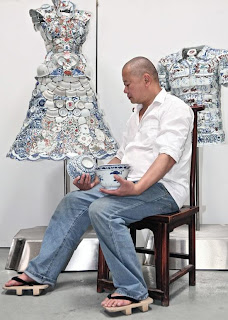Rachel Quimerez
Inverno Collection 2013
Rachel Guimerez is a Brazilian Fashion Designer, specialising in knitted garments. For her latest collection, ‘Inverno’, she is using solely recycled materials.
‘In the point of view of the planet, throwing waste away isn’t possible, because nothing will leave here, until the day NASA provides us with a rocket... We decided not to buy anything else when we realised that we had it all’, [Rachel Guimerez, 2013]
She saved ‘anything that is left over’ from her production line from the last eight collections and four years of work. This amounted to ‘almost one ton of wool, cotton, silk, polyamide and acrylic, and all types of fibres’. 500g of one of these materials is what is necessary to make one piece. Instead, they had bundles of 300g, 200g, and even less. Her and her team needed to ‘separate colours, divide textures, put the tones together and start’. This means that each piece has to be individually designed and is completely unique. ‘This is a reasonable and creative way to use resources’
What Guimerez is doing would not have been out of place 100 years ago. Sewers would use every scrap of their clothes making materials. Any amounts of material too small to form part of a new garment would be used to patch or mend. In the modern age clothes aren’t made, they’re bought from shops and so the consumer has no control over the wastage of the garment they’re buying. This means they wont have a matched piece of material to patch a jumper if they make a hole. Taking it to a seamstress and paying for the repairs or alteration would normally cost more than buying a new jumper, and so logically it makes sense to bin the old and buy the new.
The continuous wastage we now face as a world is why designers like Guimerez are so important in the development of fashion. In this money motivated continent, designers like Guimerez get people excited about craft and making things for free.
Flor de Lotus
One way of cutting down environmentally unfriendly out-sourcing is to find a more financially viable production plan within the country. Although seemingly improbable, Rachel Guimerez found a solution. And ‘so with this will of creating fashion that goes beyond tendencies, beyond disposability, that brings cultural and emotional elements, ‘Doiselles’ developed the ‘Flor de Lotus’ project’ [Guimerez, 2012]. The project involved Guimerez training 18 prisoners at Brazils’ ‘Arisvaldo de Campos Pires’ maximum security prison. She’d teach them intricate knitting and crochet techniques to produce garments sold under her clothing brand Doiselles.
The initiative ‘is a chance for prisoners to earn money while serving time’. In addition, for every three days worked, one day is taken off the workers release date. Initially to some, the thought of wearing a garment hand crafted by a murderer may spur repulsion, but there are massive benefits to the scheme. ‘The project gives prisoners confidence, and skills they can use in the outside world... the project boosts prisoners’ chances of finding a job when their sentences are up’ [Celio Tavares, former prison inmate]. Most of the prisoners at the jail have ‘spent more time in than out’ [Celio Tavares], finding no escape from the cycle of crime. Giving the prisoners skills, savings and job potential, significantly deters them from returning to a life of crime that was awaiting them before. They are now ‘capable of changing their lives, as soon as they conquer their freedom’, [Andrea Andries, 2012]
In less developed countries in which production is often relocated to, employees are ‘frequently paid by the piece’ and homework that’s given to employees is ‘difficult to monitor’. This results in rushed work and a bad quality outcome. The alternative, are garments that are quality checked, from prisoners that are paid per day. If a customer doesn’t support the cause, they must surely still support that the cause takes trade away from factories that ‘frequently involves child labour’.
The project of course, is on a small scale and relies on compliant and enthusiastic volunteers. It doesn’t offer a full term solution to discouraging ‘sweatshops’ but it does encourage change. Offering unique hand-crafted clothing usually means customers will be more likely to spend more, to cherish and keep the garment. This hopefully resulting in less waste, then less consumption.



















































